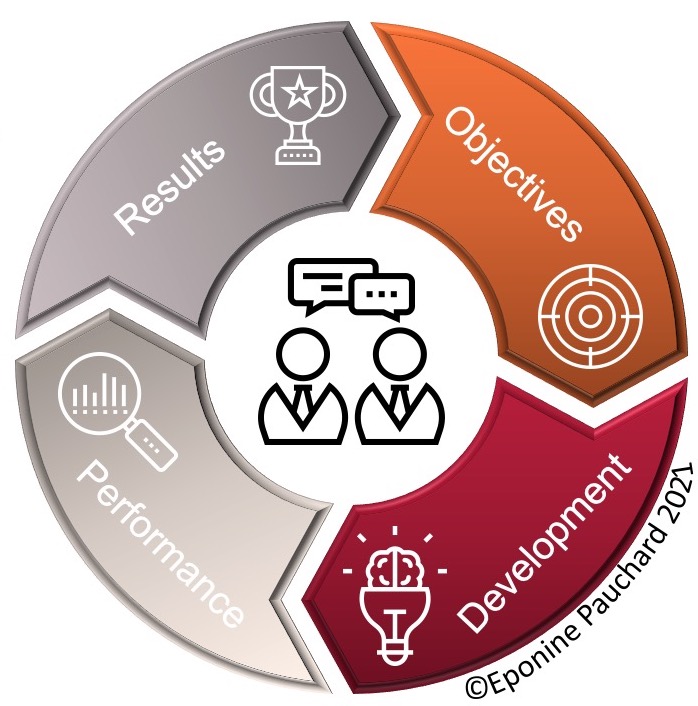Managing non-performance is difficult. So how to do it and first, why even bother? After all, we are talking about 3% or less of your team… Before you start these conversations, I explain the two components of performance and the impacts of not acting.

Performance is judged on two aspects: result and behaviour
The majority of organizations set goals relating to results. Whether quantitative, qualitative or a combination, they are usually quite simple to evaluate. The employee does not meet expectations: he has not delivered what was expected. He meets expectations: he has done what we expected him to do, both in quantity and quality. He exceeded expectations: he delivered more or better than you what you expected.
Even if they are not formally written, the company’s values are translated into expected behaviors. An employee whose values are aligned with those of the organization meets (or exceeds) expectations without even realizing it. For example, in a highly regulated sector, compliance with procedures is paramount. In a small structure, autonomy and decision-making will instead be highlighted.
To ensure fairness, you need to define the three levels of performance, to evaluate all employees in the same way. For each of the two aspects, determine what is low, medium and high. Each person is ranked according to their lowest score. A “high” employee exceeds expectations of both results and behavior.
Why should you address “low” performance?
Simply because these people will set the standard, and lower the level of expectations.
If one of your superstar employees, the sharpest expert, spends half of their day criticizing customers and colleagues behind their backs. What message does it send? The others think that this is what is expected and will soon imitate him.
In the same way, a person who is very aligned with the values but who cannot deliver the result will demotivate others… As passionate as we are, we remain human. We see what is happening around us. When it is always the same colleague who needs to be helped or whose work needs to be made up, the team perceives a sense of inequity and decreases quantity/quality.
Not addressing performance issues only makes them worse in the long run. This is how a corporate culture degrades. Everyone has to make an effort at work. If someone does not meet the expectations of the organization, they must find a position and team, which will match their values, behaviors and ability to deliver.

Regularly discuss performance
Ideally, you meet with your employees several times a year to discuss their goals, performance, development, and results. You should have a 30-minute meeting for each topic twice a year, which is a total of 8 meetings per year. You can also hold a one-hour meeting for each of the topics each year, but this is less effective. As for client feedback loops, lhigh frequency is key if you want to have more impact.
At the beginning of the year, you discuss the objectives of the coming year. The following month, you discuss the development plan, then you talk about performance, then mid-year you discuss the results obtained.

At the performance meeting, you do not discuss the objectives of the year or the results to date, but the overall work, it is a bit the last chance before discussing the non-achievement of expectations. You can rely on the development plan, and on the observations you have made. This conversation should last a maximum of 30 minutes.
To simplify your life, you can start with your “high” performers. It’s pretty easy and rewarding, both for them and for you. Share with them your pleasure of working with them. Fill up on positive energy.
Then meet your “medium” performers. The term does not make justice to them: they are good. They meet all expectations, so tell them. You can also suggest changes or suggest ways for them to become “high”. You can go back to their development plan, to support them, to share with them the changes you have noted on a daily basis. If you haven’t built a great relationshipyet, the sandwich method can help.
Finally, you will have the conversation with your “low” performer(s). This is, in my opinion, the most difficult activity for a manager. It’s a conversation that needs to be fact-based and very clear.
The best way to address problems
Forget the sandwich method, you need to be sure that the message gets through. If you drown your observations of non-achievement with other things, the person may remember only the positive.
The conversation should be simple and accurate
- Facts: “this behavior or result is not at the level of expectations”
- Reminder of the organization’s expectations and values
- Action plan: “What are you going to do to fix this?”
- Wait for the answer
Sample conversation

John, these last two weeks I have the impression that you are overwhelmed by the work to be done, you regularly complain about the difficulty/overload of work. Yesterday in the xyz meeting, you just criticized and saw everything in black, you sigh and did not propose any solution.
Our organization has great ambitions (vision). We do things that are off the beaten track (mission). We hire autonomous people, who have a sense of initiative and resourcefulness (values). What will you do to regain this type of attitude?
To respect the silence that can bother a talkative manager… Count in your head up to 100, if it is too hard, repeat the question after waiting at least until 30: Johnn, your current behavior is not at the level of the expectations of our organization, what is your plan to remedy it?
It’s up to you…
- Are expectations of results and behaviours clear to all?
- Do you rate all your employees the same way? Do you close your eyes on certain behaviors because the person is very effective? Do you accept a somewhat messy document because the person federates the team?
- Do you discuss performance with your employees?
